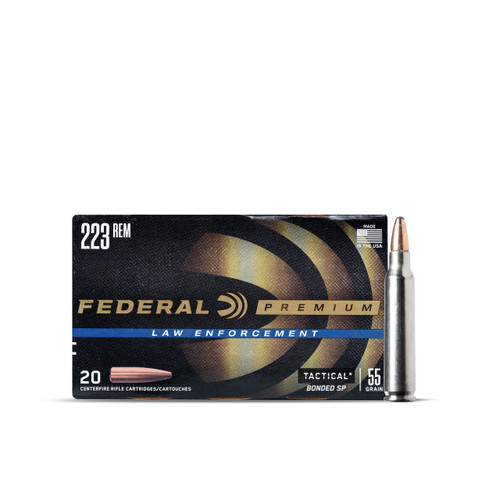.223 Remington Ammo

.223 Remington: In Depth
Early in the 1950s, a new .22 caliber centerfire cartridge began blowing holes in paper targets and dealing damage to destructive rodents. It featured a novel case design – one that Cartridges of the World, 17th Ed. called “a more-or-less scaled-down version of the .30-06” – but unlike the .30-06, there was no immediate military purpose in mind for this round (though it did have a real banger of a benchrest career). Nevertheless, within a decade of the .222 Remington’s debut, a closely-related cartridge would embark on an incredible journey through the US military, into the commercial markets, past NATO approval (as 5.56x45mm NATO) and ultimately, to worldwide preeminence.
This close familial relation – called .222 Remington Special, at first – was derived from the .222 Remington and also the .222 Remington Magnum, the latter being used in the trials of an experimental rifle design of the time called the AR-15. In order to stem confusion with the name of this new round, Armalite and co. would soon drop the Magnum and change the last 2 to a 3: .223 Remington.
The new cartridge propelled a 55-grain FMJ bullet at approximately 3,250/fps.
Near the end of the 50s, Colt purchased the rights to manufacture the AR-15, and efforts to market the new platform to the US military were underway. The rifle, with its smaller round, was easier to control during automatic fire than the recently-adopted M14 firing 7.62x51mm NATO ammunition. In fact, full auto handling of the M14 was such a serious issue that the Army was already on the lookout for a permanent replacement just as the AR-15 was wrapping up its trials and various specialty / limited adoptions around the services.
In December of 1963, Remington released the new cartridge to the commercial market. .223 Remington would first appear on store shelves alongside the Model 760 pump-action rifle.
By 1964, the Army had adopted the cartridge as “5.56mm M193 Ball”. Colt’s AR-15 rifle, now known to the military as the M16 (Air Force) and XM16E1 (Army and Marines) was making its way to troops in theater and saw immediate action.
Powder problems with initial M193 loads proved disastrous for some of the early M16s in Vietnam. However, after modifications were made to the military load and the chambers of the guns were chrome lined, the M16 gained a formidable reputation for effective jungle combat.
In 1980, NATO adopted a modified .223 Remington design as its new standard infantry round. The cartridge featured a 62-grain steel-core bullet that proved more effective against armored targets, but did not perform as well in rifles designed for M193 ammunition. As a result, when the US adopted 5.56x45mm NATO, modifications were needed for every service weapon employing the new cartridge; a faster-twist barrel being chiefly among them.
In 1994, Federal legislation prohibiting the manufacturing and importation of certain semi-auto firearms was passed. The AR-15 was among these restricted weapons.
The aftermath of what some people term the “ban years” (1994-2004) included a vigorous renewed civilian interest in semi-auto, mag-fed guns like the AR-15. The AR’s reputation for reliability along with widespread ammo availability made it a popular choice for recreational sport shooting and training – a trend that has continued over the last few decades. In addition, the rifle’s modularity has given rise to a massive parts and accessories market in the US, giving shooters a near-limitless ability to customize their guns.
Consequently, the demand for .223 Remington ammunition to feed these guns has been intense. With most folks shooting it interchangeably with 5.56x45mm NATO in their AR-15s, it remains a consistent top seller, second only to 9mm in terms of centerfire ammunition sales.
.223 Remington: Guns
Most of these guns are chambered in 5.56x45mm NATO, except for the bolt-action rifles in the last category. However, shooting .223 Remington ammo through any of these is 100% good-to-go!
AR-15 Family (5.56x45mm NATO)
- Smith and Wesson M&P Sport II
- Ruger AR-556
- Bravo Company RECCE-16
- Sons of Liberty Patrol SL
- Order a lower receiver and start building your own!
Non-AR Semi-Auto (5.56x45mm NATO)
- FN SCAR 16
- IWI Tavor
- Ruger Mini-14
- Kel-Tec RDB
- Steyr AUG A3 M1
Bolt-Action (.223 Remington)
- Remington 700 SPS Varmint
- Ruger American Predator
- Savage Axis II
Why Choose .223 Remington?
This is the cartridge you need to feed hungry modern sporting rifles. Although technically the US military now fields 5.56x45mm NATO, .223 Rem 55-gr. @ 3,240/fps is still manufactured in staggering quantities for large government contracts, both domestically and abroad. These same manufacturers produce equally impressive numbers of rounds for commercial distribution. TLDR: it’s pretty cheap to shoot.
Target / Competition
- Plinking with an AR-variant feeding .223 Remington is now a mainstay of recreational shooting.
- Target loadings with heavy 77-gr bullets that buck the wind better downrange are popular in competition shooting.
Training
- Carbine courses and similar tactical training / education heavily feature AR-15 variants. It’s common to shoot a half-case (500-rds.) or more of ammunition, depending on how many days of training are planned.
- Bulk .223 Remington ammunition has been in good supply for decades. 14,000-rd. drums are available for purchase commercially. Time to stock up!
Home Defense
- Loads are available featuring bullets that expand quickly, reducing the potential for over-penetration through drywall and other barriers in the home.
- A compact AR equipped with a suppressor to mitigate concussion and muzzle blast makes a viable option for home defense.
Hunting
- Varminting is popular with .223 Remington due to its small diameter and high velocity. Trajectory is relatively flat out to 250-300yds.
- Coyote and other predator hunting with .223 Remington is popular.
- Some folks hunt wild hogs, though larger calibers are often more advisable for creatures that are prone to charging.
- .223 Remington is capable of killing large animals with proper shot placement, however, there are better cartridge options for hunting medium-sized (and up) game.
.223 Remington: Ammo Brands and Loadings
There are plenty of companies making .223 Remington ammunition, especially the standard 55-gr. load, which is well-suited for paper targets and plinking. However, if you’re looking to explore the capabilities of this cartridge, selecting the ideal load isn’t all that difficult either. Varminting uses lighter bullets in the 35-gr. to 50-gr. range, and long-range loads use heavy 69-gr. bullets and up. If you’re going to shoot heavy bullets, make sure your barrel can stabilize them.
Brands
Standard Loading
- 55-gr. FMJ @ 3,240/fps - This is the most common general, training, target, and plinking load.
Bullet Weights
- 35-gr. to 40-gr. - Varmint and predator hunting
- 55-gr. - Standard grain weight
- 62-gr. - Various hunting
- 69gr. to 77-gr - Long-range targets
- 85-gr to 90-gr - Long-range targets
Bullet Types
- FMJ (BT, HPBT) - Full metal jacket boat-tail bullets are found in both bulk and target-specific loads.
- SP - Soft-point lead bullets are found in hunting loads and designed to expand on impact.
- V-MAX - Plastic-tipped bullets are found in many high-velocity varmint loads and also expand rapidly upon impact with soft tissue.
- Frangible - Composite bullets found in specialty training ammo that are designed to fracture immediately upon impact; especially useful inside of 75-100 yds on steel plates where normal FMJ ammo might damage the steel target or ricochet back towards the shooter.
Steel-Cased Ammunition
- Steel is a lower-cost alternative to brass-cased ammunition. To be sure, steel does not seal against chamber walls as well as brass, so your gun will run dirtier, which could lead to stoppages if no cleaning takes place. However, as a whole, steel cased-ammo isn’t typically the jam-o-matic nightmare that many make it out to be.
.223 Remington Ammo FAQ:
5.56x45mm NATO generally runs at higher pressures than .223 Remington. 5.56x45mm NATO cases also tend to have thicker brass, especially near the base. In terms of their exterior case dimensions, there is no difference.
All day long!
This is generally not a good idea. 5.56x45mm NATO barrels have longer chambers that effectively tolerate the higher pressures of NATO-spec ammo. You are risking a dangerous over-pressure situation if you use 5.56 NATO ammo in a .223 Rem barrel.
It’s possible and even legal to hunt a wide variety of animals with .223 Remington (check your state’s laws). Predators and varmints – easy work for this cartridge. However, the larger the game, the more that shot placement becomes critical. Deer and anything larger – there are far better options, though plenty of people shoot deer with this cartridge.
Yes, and there are many loads marketed specifically for home defense. In this case, the important takeaway is that .223 Remington isn’t disqualified from this role for any particular reason (over-penetration is often cited); planning, training, and situational awareness will ultimately be more important here.











